|
Location:
South East of Konya, Turkey. |
Grid Reference:
37.66˚ N, 32.82˚ E |
  �atal
H�y�k:
(The 'Forked Mound'). �atal
H�y�k:
(The 'Forked Mound').
�atal
H�y�k is now considered to be one of the earliest known 'cities' in the world.
The site was first
identified in 1958 by J. Mellart, and excavations revealed a complex of
interconnected 'mud-brick and plaster dwellings'
(3), dating from 6,500 BC which covered 32 acres
in the sixth millennium BC
(1).
The city is 8,000 - 10, 000
years old.
(4)
(Map of
site - How to get there)
|
�atal
H�y�k:
(�atal
H�y�k, 'The Forked mound') |

A series of 'extraordinary' shrines were identified which showed clear evidence of
bull veneration, a vulture cult, and signs of worship of the prehistoric mother goddess
(see right).
Collins says of it: 'The
magnificence of its art, tools, weapon and skilfully fashioned
jewellery showed a level of technology and sophistication which
has forced archaeologists to review completely their
understanding of the development of civilisation'
(2)
The use of two feline figures
in the image (right), is a common feature in many later middle-eastern
and European sculpture, in which they invariably
represent 'guardians' at places of power, such as on either side of
thrones, or at important entrances and gateways such as at Boghazkoy and
Alaja Huyuk, (see photo's below), also both in Turkey. In early Egyptian
myth the earth god Aker, (who was the divine god of the eastern and western
horizons or the entrance and exit to the underworld), was represented in
hieroglyphs as two lions sitting back to back.
It is perhaps relevant that two lions are also used in
portrayals of the legendary ante-deluvian Sumerian hero/king, Gilgamesh,
creating a direct link between Pre-Sumerian, Sumerian and Post-Sumerian
(Mesopotamian) cultural themes. The significance of the discovery of an such
an early mother-earth figure, flanked by felines, combines to enforce the
idea of an prehistoric matriarchal society, of which influences may also be
seen in
Malta,
where the mother-earth figure is given similar such reverence at
approximately the same time in history.
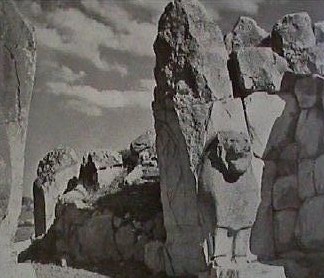

(left: Boghazkoy and
right: Alaja
H�y�k)
Note: The lions are replaced by
sphinx's at Alaja
H�y�k.
(Rows of sphinx's
were also used to line the entrances to many sacred Egyptian
temples).
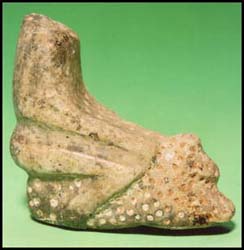
In
relation to the seated woman above, is this figure of a kneeling man
and a leopard. The jury's still out over its meaning.
Other artefacts include a polished obsidian mirror, drilled stone beads (including
obsidian), and decorated skulls. It appears that
metallurgy was also practiced
here at an early time, as the existence of smelted copper, lead, and metals,
are attested at �hatal H�y�k since level IX, c 6,400 BC.
(2) Mellaart said:
'To our great surprise we found pottery in every building-level right down
to level XIII, so that no pre-pottery phases have yet been reached. This
makes the �atal
H�y�k pottery the earliest in the near east, as level XII must probably be
dated to about 6,800 BC (+/- 100 years)'.
(3)
Clay stamp-seals:
James Mellaart said of the baked clay seals:
'Whereas the earliest are round
and small in size (level VI), the later examples are large and show a
variety of shapes, including that of a human hand. They are decorated with
fine geometric ornament in a pseudo-meander style.
Spirals also occur. None of the designs
are repeated and not more than a
single seal is ever found in a house'. (3)
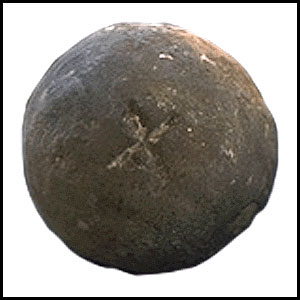
Also
of interest were the numerous clay balls found at the site. Their meaning is
conjectural.
Ground stone tools found at
�atal h�y�k include axe heads, mace heads, querns for grinding grain,
ornaments such as pendants, and mirrors of obsidian. These artefacts were
made by pecking - slowly crushing away the surface by tapping with another
rock, then grinding - wearing away the surface by abrading it with or
against another rock, and then sometimes finishing by polishing - grinding
using fine sand or silt and water.
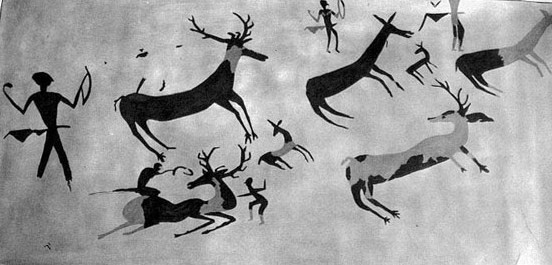 The mural paintings
at �atal h�y�k are the oldest in the world on human built structures. The
most spectacular murals found so far at �atal h�y�k are those from building
F.V.1, which portray a variety of animals and human figures. These murals
are on all four inside walls of the building but probably represent more
than one composition or scene. The people seem to be interacting with the
animals, pulling tongues, pulling tails, jumping on their backs. The animals
shown have been identified as bulls, horses, stag deer, bear and wild boar,
all of which are large and powerful and potentially dangerous to humans.
Some of the acts shown appear to be things a person could never actually do
with these animals. The mural paintings
at �atal h�y�k are the oldest in the world on human built structures. The
most spectacular murals found so far at �atal h�y�k are those from building
F.V.1, which portray a variety of animals and human figures. These murals
are on all four inside walls of the building but probably represent more
than one composition or scene. The people seem to be interacting with the
animals, pulling tongues, pulling tails, jumping on their backs. The animals
shown have been identified as bulls, horses, stag deer, bear and wild boar,
all of which are large and powerful and potentially dangerous to humans.
Some of the acts shown appear to be things a person could never actually do
with these animals.

This picture is believed by many to be a
map of
�atal
H�y�k, dated at 6,200 BC.
(Click
here for original image of map)
(More
about Prehistoric Cartography)
 These five bone rings (x1 -
x5), had been cut from a single bone and were found on the left hand
of juvenile skeleton 2119, burial 200...in the east-central platform
of Building 1. Although they appear quite large, the hole is small,
suitable only for a fairly small hand, and there is little doubt
from the wear evidence that they were worn in life by juvenile 2119,
who was buried with everyday rings on the left hand. These five bone rings (x1 -
x5), had been cut from a single bone and were found on the left hand
of juvenile skeleton 2119, burial 200...in the east-central platform
of Building 1. Although they appear quite large, the hole is small,
suitable only for a fairly small hand, and there is little doubt
from the wear evidence that they were worn in life by juvenile 2119,
who was buried with everyday rings on the left hand.

Also made from bone...this belt buckle...
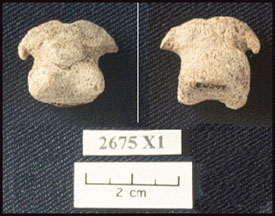
There were 254 known
figurines and fragments recorded from Mellaart's excavations.
(5)
The
clay figurine (left) dates from the 6th millennium BC.
"This figurine depicts a seated figure and
was hailed as a typical Catal hoyuk 'Mother Goddess'. In fact it is
unusual in a number of ways... it's one of the smallest
ever found at the site... although this figure has a
bulging stomach, it has no breasts... this figure has a hole in
the top of the body for the attachment of a head, which is
missing. The figurine is complete and undamaged."
Some of the anthropomorphic figurines have
removable heads, in similarity to the headless figures in the wall
paintings. (5) It is worth
noting in relation to this that the bodies of the dead inhabitants of
�atal h�y�k were often decapitated. Several of the
female-goddess figurines on Malta also show this
same design feature.
 Vulture worship -
In many of the shrines the walls were adorned
with enormous skeletal representations of vultures.
Human breasts were found moulded on the walls from plaster, behind which
were found actual vulture skulls with their beaks protruding to form the
nipples. The emulation of the vultures can be interpreted in terms of an
association with the death process. The elaborate decoration of the shrines
suggests the presence of a 'priesthood', and presumably, some concept of an
afterlife. Vulture worship -
In many of the shrines the walls were adorned
with enormous skeletal representations of vultures.
Human breasts were found moulded on the walls from plaster, behind which
were found actual vulture skulls with their beaks protruding to form the
nipples. The emulation of the vultures can be interpreted in terms of an
association with the death process. The elaborate decoration of the shrines
suggests the presence of a 'priesthood', and presumably, some concept of an
afterlife.
Note: The
Vulture is often portrayed in Egyptian hieroglyphs as carrying the 'Ba' or
'soul', (left), perhaps justifying Collins theory of an association between
the prehistoric people of the Anatolian highlands and the 'Elder-Gods',
spoken of in Egyptian mythology
(2).
Evidence from recent (1999)
examination of human remains at the site indicate that excarnation
(removal of flesh after death as a result of vultures etc). was not
carried out as once thought. (5)
Bull Worship
- The discovery of evidence of 'Bull
veneration' at this early time in prehistory is not uncommon. The same theme
is repeated in art from prehistoric
Crete,
France,
England
and
Egypt (amongst others), and the veneration of
bulls is still
practiced in countries such as
India
and
Spain. Cattle clearly played an
important role in prehistoric affairs and cattle bones have been found at
many European megalithic structures. The palace of Knossos on Crete, had
similar horns and murals as those found at
�atal
H�y�k, making it tempting to suggest a connection, as is the discovery of
cattle-veneration in
Egypt, which was predictably
carried to the extreme; For example, at the
Saqqara complex where the bull frieze
(below, left) came from, an early dynastic tomb was discovered containing
500 mummified cattle, and one of the most important gods of the Egyptian
patheon was the (pre-dynastic) cow-Goddess Hathor ('Hat'-'Hor' - 'House of
Horus'), who symbolised fertility, motherhood, and was the sky goddess,
who's four legs were envisioned straddling the earth marking the cardinal
points.

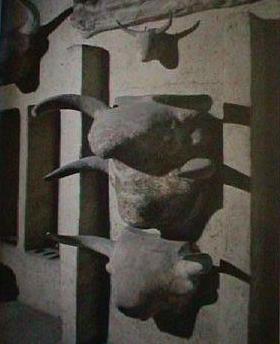

Egyptian (saqqara - left) and Anatolian
bull worship (centre and right).
Velikovsky
suggested that the origin of prehistoric bull-veneration was related to the
arrival of the planet Venus, which he believed was witnessed, and from
whence came the apparent universal calendar change from 360 days to 365
days. The discovery of such obvious evidence of cattle-worship from before
the time he predicted, is not in favour with this theory. Such an early date
does tie in nicely with another theory however, as it accords nicely with the
motions of the 'Platonic year'.
T here have
been several serious suggestions that the understanding of
prehistoric astronomy extended to the recognition of the 'precession
of the equinoxes', which has a cycle lasting approximately
25,960 years, and is measured by the gradual rotation of the zodiacal
constellations on the horizon at the equinoxes). The product of such
observations was the division of the sky into twelve equal parts, each
occupied by a constellation, and each being visible at the equinoxes for a period of approximately 2,160 years.
Although Plato's name is attached to this theory, it
is known
from Sir N. Lockyer's research at temples such as
Denderra in Egypt, that the
procession of the equinoxes was a recorded phenomena from long before the
Greeks. Just how far back is a question yet to be answered, although it is
tempting to associate the
prehistoric veneration of cattle with the 'age of Taurus', which occurred at
the same time as the constellation of Taurus was the
'rising' constellation at the equinoxes. It has also been suggested in
relation to this, that the Sphinx was a remnant of the 'age of Leo', and
that Christianity is symbolic of the 'age of Pisces'.
It is perhaps worth noting, in relation to this theme, the discovery of a
marble figurine of a kneeling/sitting 'twin-goddess', as well as a scene on
the wall of a shrine showing twin goddesses with two heads, two bodies but a
single pair of legs.
(3)
Gallery of Images:
�atal
H�y�k,
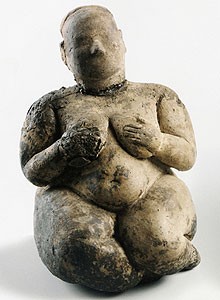
Female Figurine: Seated and Holding her own Breasts.
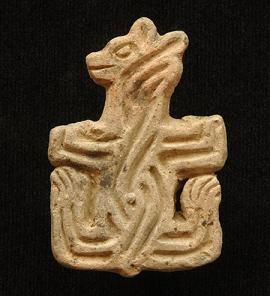
Two-dimensional animal figurine: Perhaps representing the skin of a dead
bear
|






 The mural paintings
at �atal h�y�k are the oldest in the world on human built structures. The
most spectacular murals found so far at �atal h�y�k are those from building
F.V.1, which portray a variety of animals and human figures. These murals
are on all four inside walls of the building but probably represent more
than one composition or scene. The people seem to be interacting with the
animals, pulling tongues, pulling tails, jumping on their backs. The animals
shown have been identified as bulls, horses, stag deer, bear and wild boar,
all of which are large and powerful and potentially dangerous to humans.
Some of the acts shown appear to be things a person could never actually do
with these animals.
The mural paintings
at �atal h�y�k are the oldest in the world on human built structures. The
most spectacular murals found so far at �atal h�y�k are those from building
F.V.1, which portray a variety of animals and human figures. These murals
are on all four inside walls of the building but probably represent more
than one composition or scene. The people seem to be interacting with the
animals, pulling tongues, pulling tails, jumping on their backs. The animals
shown have been identified as bulls, horses, stag deer, bear and wild boar,
all of which are large and powerful and potentially dangerous to humans.
Some of the acts shown appear to be things a person could never actually do
with these animals.
 These five bone rings (x1 -
x5), had been cut from a single bone and were found on the left hand
of juvenile skeleton 2119, burial 200...in the east-central platform
of Building 1. Although they appear quite large, the hole is small,
suitable only for a fairly small hand, and there is little doubt
from the wear evidence that they were worn in life by juvenile 2119,
who was buried with everyday rings on the left hand.
These five bone rings (x1 -
x5), had been cut from a single bone and were found on the left hand
of juvenile skeleton 2119, burial 200...in the east-central platform
of Building 1. Although they appear quite large, the hole is small,
suitable only for a fairly small hand, and there is little doubt
from the wear evidence that they were worn in life by juvenile 2119,
who was buried with everyday rings on the left hand. 

 Vulture worship -
In many of the shrines the walls were adorned
with enormous skeletal representations of vultures.
Human breasts were found moulded on the walls from plaster, behind which
were found actual vulture skulls with their beaks protruding to form the
nipples. The emulation of the vultures can be interpreted in terms of an
association with the death process. The elaborate decoration of the shrines
suggests the presence of a 'priesthood', and presumably, some concept of an
afterlife.
Vulture worship -
In many of the shrines the walls were adorned
with enormous skeletal representations of vultures.
Human breasts were found moulded on the walls from plaster, behind which
were found actual vulture skulls with their beaks protruding to form the
nipples. The emulation of the vultures can be interpreted in terms of an
association with the death process. The elaborate decoration of the shrines
suggests the presence of a 'priesthood', and presumably, some concept of an
afterlife.


